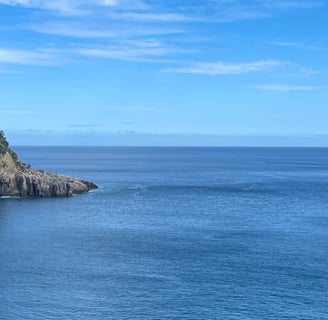The Azores: A volcanic archipelago of 9 incredibly diverse, jaw droppingly gorgeous islands located approximately 1,000 miles west of mainland Portugal.
With tourism exploding over the last several years, it is no surprise that finding peace on a buzzing island like São Miguel proves to be quite a challenge. That is, unless a hillside cow pasture, while beautiful in its own right, tickles your fancy. But if you know where to look, you might just find yourself leaving behind the camera-bearing swarms of tourists we love to hate, adventuring down an old footpath once used by those who worked the vertical lands we still appreciate today.
The Road Less Traveled
Although most enthusiasts recommend an approximately 10 mile, out-and-back trek (known as the PR12 SMI Agrião) starting in Povoação, and working your way west to the small fishing parish called Ribeira Quente, I would recommend a different approach.
Instead, begin your journey in Ribeira Quente by the fishing camp by Rua de Trincheira 8, and cross over the small bridge leading to a bustling café, Café Adelino. If you're like me, you'll stop for a glass of wine or espresso (depending on the time of day) and continue straight onto a street called Canada dos Barbosas, leading into a small residential area. You may feel out of place at first, but with a friendly cat escort through the streets, you will soon find yourself on the western-most point of the Agrião Trail.
Hidden Gems and Sacred Spaces
Explore the trail as far as you'd like before turning back, but make sure to make it out (a short distance) to a religious monument where you will learn more about the rich history of São Miguel while taking in some of the most beautiful coastal views the island has to offer, sans the crowds.
As you continue past the monument, you'll discover hidden lookout points unmarked on tourist maps. These spots reveal secret black sand beaches below, accessible only during low tide, where local fishermen still practice traditional fishing methods. The volcanic cliffs here display stunning geological formations, with layers of ancient lava flows visible in the rock face.
Watch for endemic Azorean flora along the trail edges – the bright blue Azorean bellflower and the rare Azores juniper often surprise hikers in spring and early summer. If you're lucky, you might spot Cory's shearwaters nesting in the cliffs or short-eared owls hunting in the early morning hours.
Tips for the Trail-Weary Wanderer
I suggest exploring the rest of the Agrião Trail another day, starting from the eastern point in Povoação and working your way west. This allows you to experience all the trail has to offer without feeling like you should be in a body cast by the end of the day. (Or maybe that would just be me.)
For those brave souls tackling the full trail, here are some essential tips:
Pack micro-spikes or sturdy hiking poles for the steep sections, especially after rain
Bring more water than you think you need – the humid climate can be deceptive
Download offline maps – cell service is spotty at best
Pack layers – the weather can shift dramatically between the coastal and elevated sections
Allow 6-8 hours for the full trail, accounting for photo stops and rest breaks
Consider arranging a pickup in Povoação instead of hiking back
Start early to avoid afternoon heat and sudden coastal fog
The trail difficulty varies significantly by section:
Ribeira Quente to the shrine: Easy, well-maintained paths
Middle section: Challenging, with steep ascents and primitive stairs
Povoação approach: Moderate to difficult, with exposed sections
Don't hesitate to turn back if weather conditions deteriorate – the coastal winds can be treacherous, and the clay-rich soil becomes extremely slippery when wet.
Other Hidden Trails Worth Exploring
For those seeking additional solitude, consider these lesser-known paths:
The ancient footpaths of Sete Cidades, away from the main viewpoints
The forgotten tea workers' trails near Porto Formoso
The shepherd paths above Furnas Valley
The coastal trails near Nordeste, where locals still tend to their crops
Best Times for Solitary Hiking
To maximize your chances of solitude on the eastern side :
Start early, before 8 AM
Choose weekdays over weekends
Visit during shoulder season (April-May or September-October)
Remember to respect local properties and close any gates you encounter - many of these trails cross working farmland. The authentic São Miguel experience isn't found on Instagram hotspots, but rather in these quiet corners where tradition still walks hand in hand with nature.


